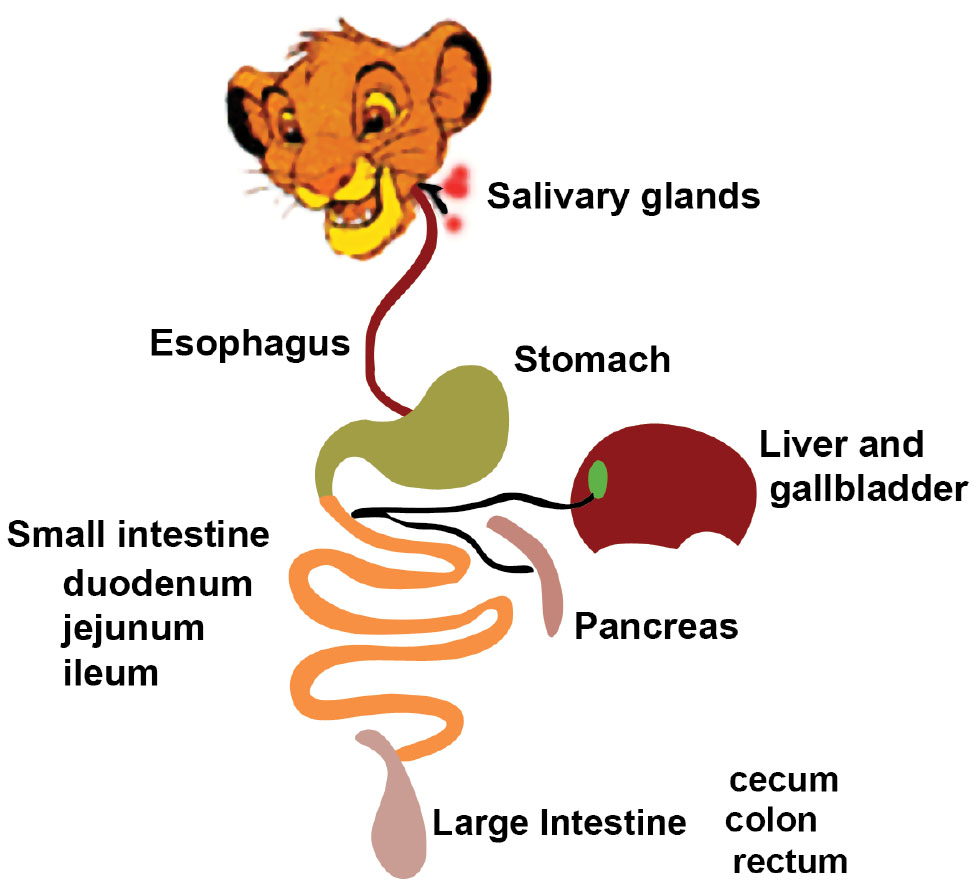Humans are designed to eat meat. We know this through comparisons to other mammals:
Intestine and stomach(s):
Some mammals eat only meat or only plants, or both. Even though we get food from different sources, we're all mammals and need to obtain a similar set of nutrients. By calories, mammalian diets are typically composed of a majority, (typically 50-75%) of saturated and monounsaturated fats (including the short-chain fatty acids produced by fermentation of fiber); a mix of carbohydrates and protein (usually totaling around 25-40%) and a modest amount of polyunsaturated fat, typically less than 10%. These mixtures of macronutrients can be extracted from many mixtures of foods -- if you CAN extract them properly.
You can simply look at an animal's digestive tract to determine what types of material can be broken down in there. Animals have evolved variations in organs and fluids to break down foods to supply us with energy and energy-storage. Animals have evolved digestive tracts and livers to transform diverse food inputs into the uniform set of nutrients that all they need. Digestive tract length is a good indicator of what types of food an animal can process:
- A cow wouldn't know what to do with meat in its gut, they have a 30 meter digestive tract. Herbivores have foregut organs such as rumens or hindgut chambers for fermenting carbohydrates, turning them into fats and volatile acids that can be used to manufacture fats.

- A lion wouldn't know what to do with grass in his gut, they have a seven meter digestive tract. Carnivores have livers capable of turning protein into glucose and fat. Meat digests more easily and the micronutrients are more easily extracted and a shorter gut length is fine.

- Humans are lucky bastards we can handle either we're omnivores - but which do we 'need' to consume. For example we NEED sugars for muscle and brain fuel, so we have to eat sugar? Consuming carbohydrates and sugars is redundant, like lions humans have livers which make our own sugars from the proteins and fats in our system. In fact, consuming any outside sources carbohydrates is 'nonessential' but the vitamin density of leafy greens and root/tubor have micronutrients which are essential. Note, there is a variation across humans as well. Humans with longer colons allow more fermentation of plant fiber, but the the presence of a longer colon doesn’t dramatically change required macronutrient ratios of the diet. Across human populations, the optimal human diet probably doesn’t vary in any macronutrient by more than 5% of energy or so.
 A good rule of thumb for our diets is that humans have always made good fasters- we can go for weeks without eating, think about eating a diet that is similar in macronutrients to what we are made of.
A good rule of thumb for our diets is that humans have always made good fasters- we can go for weeks without eating, think about eating a diet that is similar in macronutrients to what we are made of. Teeth
I've heard the argument that 'look, we have canine teeth therefore we're carnivores'. This isn't a good argument, compare ours to a gorillas, their canine teeth are so long they're behind their eyeballs. Sorry, teeth don't tell a story about human food because we've been cutting our food up with tools long enough that we haven't needed to bite through a rhinoceros's hide for quite a while (pre homo sapien, in fact.). The introduction of tools is what allowed our canine teeth and the supporting muscles to atrophy over millennia. Shrinking teeth meant shrinking jaw muscles. Those muscles were binding our skulls into a shape that ceased brain development. The order may seem counterintuitive: Tools -- shrinking teeth -- smaller jaw muscles -- bigger brains. All of this was set 77,000 generations ago.
I'll hit up the summary of why some people collect fat in different locations in a following post. Spolier alert, it has to do with the same reasons we grow hair in more places than others.